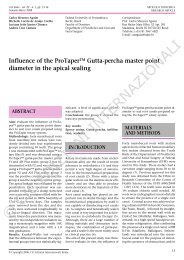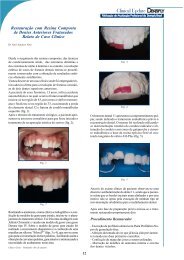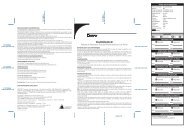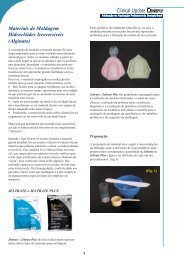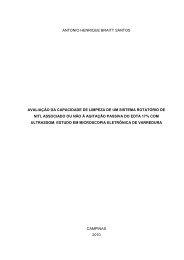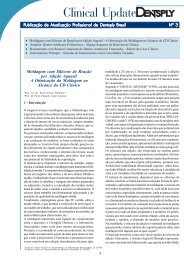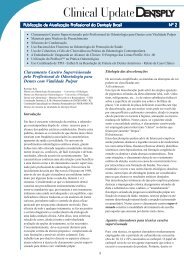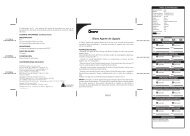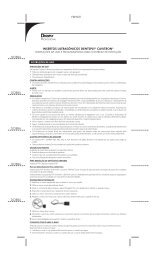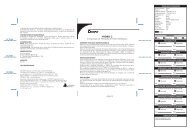You also want an ePaper? Increase the reach of your titles
YUMPU automatically turns print PDFs into web optimized ePapers that Google loves.
Six-month Clinical Evaluation of XP BOND in Noncarious<br />
Cervical Lesions<br />
Uwe Blunck a /Katharina Knitter b /Klaus-Roland Jahn c<br />
Purpose: To evaluate the 6-month clinical performance of the etch-and-rinse one-bottle adhesive system XP BOND,<br />
used in combination with the composite resin CeramX Duo for the restoration of Class V noncarious cervical lesions<br />
(NCCL).<br />
Materials and Methods: XP BOND was tested in a total of 40 patients who received two Class V CeramX Duo restorations,<br />
Adper Scotchbond 1 XT was used as a control. After cleaning the teeth, the surface of the NCCL was treated<br />
using a carbide bur in dentin and a 40-μm diamond bur in enamel with no retentive preparations. The lesions were<br />
filled with two increments of CeramX Duo after the application of the respective adhesive by a single operator according<br />
to manufacturer’s instructions. After 6 months, the retention and the marginal integrity were evaluated.<br />
Results: Thirty-eight of 40 patients were evaluated after 6 months by two clinicians according to modified USPHS criteria,<br />
and all restorations using XP BOND were still in place. In the control group (using Adper Scotchbond 1XT), one<br />
restoration was lost. The statistical evaluation (chi 2 test) showed no significant differences in any of the criteria. No<br />
difference of marginal integrity was found between the two adhesive systems.<br />
Conclusion: XP BOND meets the ADA success criteria after 6 months.<br />
Keywords: clinical study, noncarious cervical lesions, Class V restorations, adhesive systems.<br />
J Adhes Dent 2007; 9:265-268. Submitted for publication: 15.12.06x; accepted for publication: 3.1.07.<br />
In operative dentistry, etch-and-rinse systems form an important<br />
group of bonding agents that are clinically widely<br />
used. However, as these systems require the demineralization<br />
of dentin and the exposure of the embedded collagen<br />
network, numerous concerns regarding drying of the protein<br />
mesh arise. 5,6,8 This is due to the need to rinse and carefully<br />
a Associate Professor, Charité-Universitätsmedizin Berlin, Dental School, Campus<br />
Virchow Clinic, Berlin, Germany.<br />
b Assistant Professor, Charité-Universitätsmedizin Berlin, Dental School, Campus<br />
Virchow Clinic, Berlin, Germany.<br />
c Professor, Charité-Universitätsmedizin Berlin, Dental School, Campus Virchow<br />
Clinic, Berlin, Germany.<br />
Paper presented at Satellite Symposium on Dental Adhesives, Dublin,<br />
September 13th, 2006.<br />
Reprint requests: Dr. Uwe Blunck, Charité-Universitätsmedizin Berlin, Dental<br />
School, Campus Virchow Clinic, Augustenburger Platz 1, 13353 Berlin, Germany.<br />
Tel: +49-30-450-562-673, Fax: +49-30-450-562-961. e-mail:<br />
uwe.blunck@charite.de<br />
dry the surface after acid etching, in order to enable the constituents<br />
of the bonding system, specifically the uncured<br />
monomers, to penetrate the outer layers of the prepared<br />
dentin. It has therefore been proposed that a bonding system<br />
capable of penetrating dry and collapsed demineralized<br />
dentin would improve bonding, resulting in better clinical<br />
performance. 8<br />
XP BOND is a new one-bottle etch-and-rinse adhesive,<br />
composed of a pre-mixed solution of monomers dissolved in<br />
tert-butanol. Due to an improved ability to diffuse through<br />
partially collapsed demineralized dentin, it is claimed to be<br />
less technique sensitive. 2<br />
As for any other new dental restorative, data from clinical<br />
investigations are crucial to assess the effectiveness and reliability<br />
of the product before being launched. This is needed<br />
in order to validate results from the in vitro studies. As<br />
generally accepted for investigating the clinical effectiveness<br />
of such adhesive systems, noncarious Class V restorations<br />
are the standard test. 9,13 This is due to the fact that<br />
they do not provide any macromechanical retention, they require<br />
at least 50% bonding to dentin, and they are widely<br />
Vol 9, Supplement 2, 2007 265



